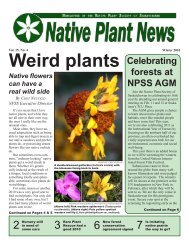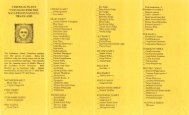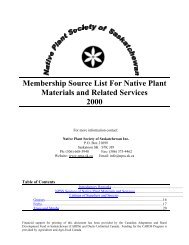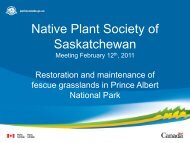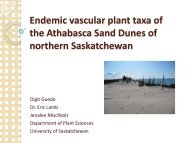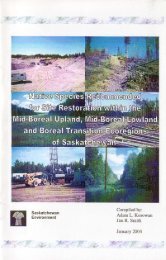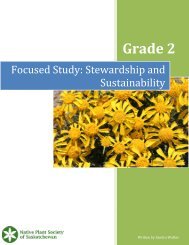Saskatchewan Guidelines For Use Of Native Plants In Roadside ...
Saskatchewan Guidelines For Use Of Native Plants In Roadside ...
Saskatchewan Guidelines For Use Of Native Plants In Roadside ...
Create successful ePaper yourself
Turn your PDF publications into a flip-book with our unique Google optimized e-Paper software.
<strong>Saskatchewan</strong> <strong>Guidelines</strong> <strong>For</strong> <strong>Use</strong> <strong>Of</strong> <strong>Native</strong> <strong>Plants</strong> <strong>In</strong> <strong>Roadside</strong> Revegetation<br />
Field Guide<br />
Figure 4. Preparing a seed bed<br />
just prior to seeding. Many<br />
combinations of techniques can<br />
be used to prepare a seed bed,<br />
depending what condition the site<br />
is in prior to seeding. <strong>In</strong> this case,<br />
harrows were used to give the soil<br />
a fine texture and to help pack it,<br />
and a rock rake followed by a<br />
rock picker (pictured) eliminated<br />
stony areas. Photo by Kerry<br />
Hecker, Canadian Wildlife<br />
Service/Environment Canada.<br />
3. Other Considerations<br />
Finally, use the remainder of the time to finish planning the revegetation project using the<br />
information collected by the vegetation surveys and photo plots. Confirm seed mixes and<br />
delivery dates, and make final adjustments to the preliminary plan. Make sure that all<br />
equipment to be used in the process will be available and in working order. Everything<br />
must be prepared in time for the revegetation, as the window of opportunity may be quite<br />
small and the process will proceed quickly; there will not be any time to wait for<br />
something that is not ready.<br />
III. Revegetation<br />
1. Laying Sod<br />
If laying native sod, simply roll out the sod onto the prepared soil surface. Make sure<br />
that the edges of sod pieces butt against one another as closely as possible, and fill any<br />
gaps with soil. Sod still requires the same site preparation as seeding, as it is important to<br />
have good root to soil contact to ensure sod survival. Lightly spraying the area with<br />
water before and after laying sod is not mandatory, but will be beneficial to sod<br />
establishment.<br />
Equipment Needed<br />
- Cultivator and/or discer for highly compacted soil<br />
- A packer for loose soil<br />
- Tractor to pull aforementioned implements<br />
- Trucks and trailers to transport sod and equipment<br />
- Water truck<br />
- Sprayer if herbicide application needed<br />
2. Seeding<br />
Seeding can begin any time after the soil preparation is finished. Ideally, the soil should<br />
be moist enough to resist blowing away, but not so moist that it sticks to equipment.<br />
Spring and fall are the two ideal times to seed.



